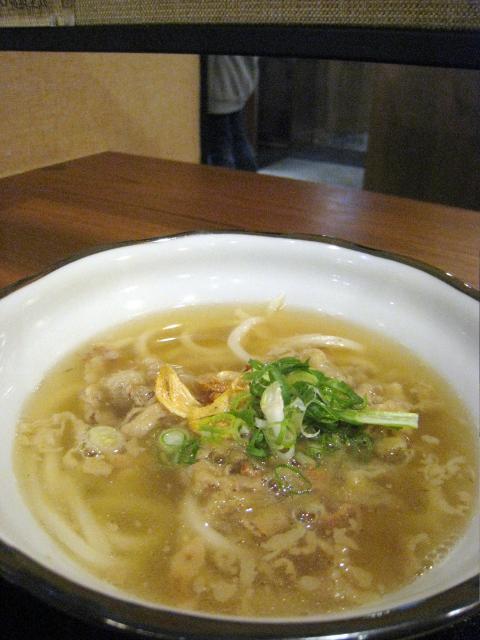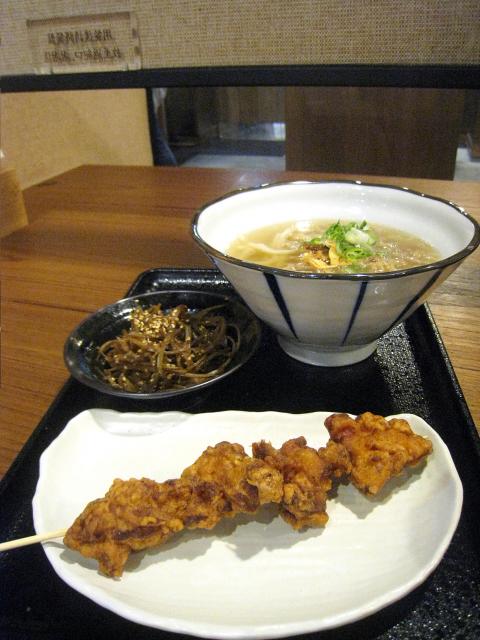As has been pointed out before in these pages, Japanese ramen has become the dominant noodle for specialist noodle stores around Taipei, to the considerable detriment of the many other types of noodles available. So it is with delight that we welcome the recent opening of Inaka Udon (稻禾烏龍麵) just a stone’s throw from the Zhongshan MRT Station, with another outlet to open next month in Eslite’s Xinyi flagship store.
Inaka Udon specializes in dishes using the udon noodle, a fat wheat flour noodle that when prepared properly, should provide a sumptuous body along with just a hint of resistance to the bite. The basic udon dish, served with a mild stock made from dashi and flavored with soy, bonito or other ingredients, is deceptively simple, and the number of places offering utterly indifferent udon are beyond count.
Inaka Udon, which targets the budget diner, does a pretty good job with both noodles and broth. As the restaurant’s name suggests, it specializes in udon and the noodles themselves are made on the premises.

Photo: Ian Bartholomew, Taipei Times
It can be a little confusing when you first walk into Inaka, since there seem to be no service staff and the buffet counter requires some navigating. Instructions are posted, but it is slightly off putting to have to read a how-to manual when all you want is a meal. It is recommended that you first select from the deep fry counter, then select from the cold side dish counter, then finally make you order of a bowl of udon noodles at the noodle counter. The whole thing is then tallied up, you pay your bill, you then hit the condiments counter for a selection of ingredients to enhance your dish, then sit down to enjoy a light, balanced and flavorful meal.
The highlight of the deep fry counter is the fried chicken, which is crisp, flavorful and at just NT$60 a skewer, remarkably inexpensive. Shrimp tempura at NT$80 is a little on the pricy side, but then shrimp always seems to command a premium regardless of how unremarkable it actually tastes.
Deep fried onion tempura is also available for NT$50, and it makes a splendid textural contrast with the noodles.

Photo: Ian Bartholomew, Taipei Times
At the cold counter there is cucumber with miso dressing (NT$50), burdock salad (NT$40), tomato with plum dressing (NT$60, highly recommended) and a Japanese style salad (NT$50). All are well prepared and pack bundles of flavor. The only complaint is that the deep fried food can be a little cold and limp if you happen to catch it during a quiet period.
The establishment’s signature dish is the garlic beef udon (蒜香牛丼, NT$160). It takes seconds to prepare at the noodle counter, as all the ingredients are pre-prepared. The service is quick and efficient, but watching the staffer ladle out the garlic beef over the quickly blanched noodles had a slightly institutional feel, tainting the sophisticated atmosphere that the restaurant has been remarkably successful in creating through clever choice of furnishing and elegant crockery.
That said, the flavoring of the garlic beef broth is quite subtle and doesn’t overburden either taste buds or digestive system, and provides a lovely complement to the noodles.
The kimchi udon (泡菜烏龍麵, NT$150) and udon with curry sauce (咖喱拌麵, NT$140), with hints of chili heat, are an excellent choice for the adventurous diner. To taste the udon at its most unadorned, try the noodles with a simple soup dipping sauce (沾麵, NT$110). Freshly made udon makes a huge difference, allowing Inaka to compete with more upscale Japanese restaurants, if only in terms of its noodles.
There is a bell at the door that customers can strike if they have enjoyed their meal. On the occasions I have visited, the cheerful chime of a satisfied diner could be heard quite regularly.
To celebrate its opening, discounts of NT$10 and NT$20 are being offered on dishes, making a meal at Inaka an excellent deal. The clever way that sophisticated food is served in a stylish environment for a good price should ensure that Inaka will survive its transition to regular pricing once its operations are fully underway.

Earlier this month Economic Affairs Minister Kuo Jyh-huei (郭智輝) proposed buying green power from the Philippines and shipping it to Taiwan, in remarks made during a legislative hearing. Because this is an eminently reasonable and useful proposal, it was immediately criticized by the Chinese Nationalist Party (KMT) and Taiwan People’s Party (TPP). KMT Legislator Chang Chia-chun (張嘉郡) said that Taiwan pays NT$40 billion annually to fix cables, while TPP heavyweight Huang Kuo-chang (黃國昌) complained that Kuo wanted to draw public attention away from Taiwan’s renewable energy ratio. Considering the legal troubles currently inundating the TPP, one would think Huang would

President William Lai’s (賴清德) National Day address was the source of far more activity and response than the speech itself warranted. The reactions to the speech and subsequent events by the local press, the international press and the Chinese Communist Party’s (CCP) mouthpieces were all very different. Michael Turton’s excellent piece, “Lai lays out the future” in the Oct. 14 edition of this paper, provided some much-needed context and a critical examination of some crucial domestic issues Lai failed to address, adding the glorious comment: “the world parses Lai’s speech like Roman priests inspecting the guts of a sacrificial animal

Last week two magnificent exhibitions opened in London. Both have as their theme the idea of the Silk Road, an-overland trade route said to stretch ever since antiquity all the way across Asia from China to Turkey and hence to Mediterranean Europe. The show at the British Library is entitled A Silk Road Oasis: Life in Ancient Dunhuang and focuses on the extraordinary haul of ancient documents found in the Mogao Buddhist cave temples by a Chinese Daoist priest and sold by him to the explorer and archaeologist Aurel Stein in 1907. Its treasures include the celebrated ninth-century Diamond Sutra, the earliest

Taipei Mayor Chiang Wan-an (將萬安) last week told residents to avoid wearing scary Halloween costumes on the MRT so as not to alarm other passengers. Well, I thought, so much for my plan to visit Taipei dressed as the National Development Council’s (NDC) biennial population report “Population Projections for the Republic of China (Taiwan): 2024-2070,” which came out last week. Terms like “low birth rate” and “demographic decline” do not cut it — the report is nothing short of a demographic disaster. Yet, in Taiwan, as in other countries, it is solvable. It simply requires a change in mindset. As it